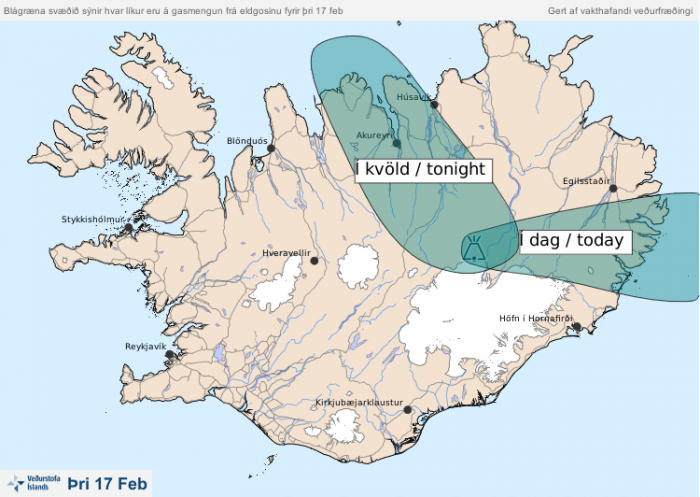The Scientific Advisory Board of the Icelandic Civil Protection has released the latest facts about the volcanic eruption in Holuhraun:
The volcanic eruption in Holuhraun continues. The eruption is still strong although it continues to diminish. Seismic activity in Bárðarbunga continues to be strong. The strongest earthquake since the last meeting of the Advisory Board on Friday was measured M4.5 on Friday, 13th of February, at 21:22. Two other earthquakes stronger then magnitudes M4.0 were detected over the period and three between M3.0-3.9. In total around 70 earthquakes were detected around the caldera since last Friday. No earthquake over M5.0 has been detected in Bárðarbunga since 8. January. Around 60 earthquakes were detected in the dyke during the same period. All smaller than M2.0. GPS measurements near northern Vatnajökull glacier show continuing slow deflation towards Bárðarbunga. About 40 earthquakes were detected around Herðubreið and Herðubreiðartögl since Friday. The strongest was M2.0 yesterday at 03:39. About 10 earthquakes were detected around Askja and three in Tungnafellsjökull.
Air quality:
- Today (Tuesday) gas pollution is expected east of the Volcano, but north and northwest of it tonight. Tomorrow (Wednesday) pollution is expected northeast of Holuhraun.
- The Icelandic Met Office provides two-day forecasts on gas dispersion from the eruptive site in Holuhraun. Most reliable are the forecast maps approved my meteorologist on duty, see Gas forecast. And although still being developed further, an automatic forecast, see Gas model, is also available (trial run, see disclaimer).
- Measurements of air quality can be found on the webpage www.airquality.is Data from handheld gas monitors, spread around the country, can also be found on that page
Instructions from the Crisis Coordination Centre:
- People who feel discomfort are advised to stay indoors, close their windows, turn up the heat and turn off air conditioning. Use periods of good air quality to ventilate the house. People experiencing adverse effects should be in immediate contact with their healthcare centre. Measurements of air quality can be found on the webpage www.airquality.is The Meteorological Office issues forecast on its web-page and warnings if conditions change to the worse.
- Instructions from The Environment Agency of Iceland and Chief Epidemiologist can be found on their web-sites.
- Check the Icelandic Met Office forecasts for sulphuric gas dispersion on the web as described above.
- Handheld meters have been distributed around the country for SO2 measurements three times a day.
- Information and any questions on air pollution can be sent to The Environment Agency through the email gos@ust.is. The Environment Agency is especially looking for information from people who have been in contact with high concentrations of gas; where they were, at what time it happened, how the gas cloud looked (colour and thickness of the cloud) and how they were affected by it.
Three scenarios are considered most likely:
The volcanic eruption has now been going on for over five months, the lava flow is still great in Holuhraun and the rate of the subsidence of the Bárðarbunga caldera is still significant. Three scenarios are considered most likely:
- The eruption in Holuhraun continues until the subsidence of the Bárðarbunga caldera stops. The eruption can still go on for many months.
- The volcanic fissure may lengthen southwards under Dyngjujökull, resulting in a jökulhlaup and an ash-producing eruption. It is also possible that eruptive fissures could develop in another location under the glacier. If such an eruption would be prolonged it could eventually produce a lava flow.
- Volcanic eruption in the Bárðarbungu caldera. Such an eruption would melt large quantities of ice, leading to a major jökulhlaup, accompanied by ash fall.
Other scenarios cannot be excluded.
The National Commissioner of the Icelandic Police, Department of Civil Protection and Emergency Management Almannavarnir www.avd.is/en Twitter: @almannavarnir

